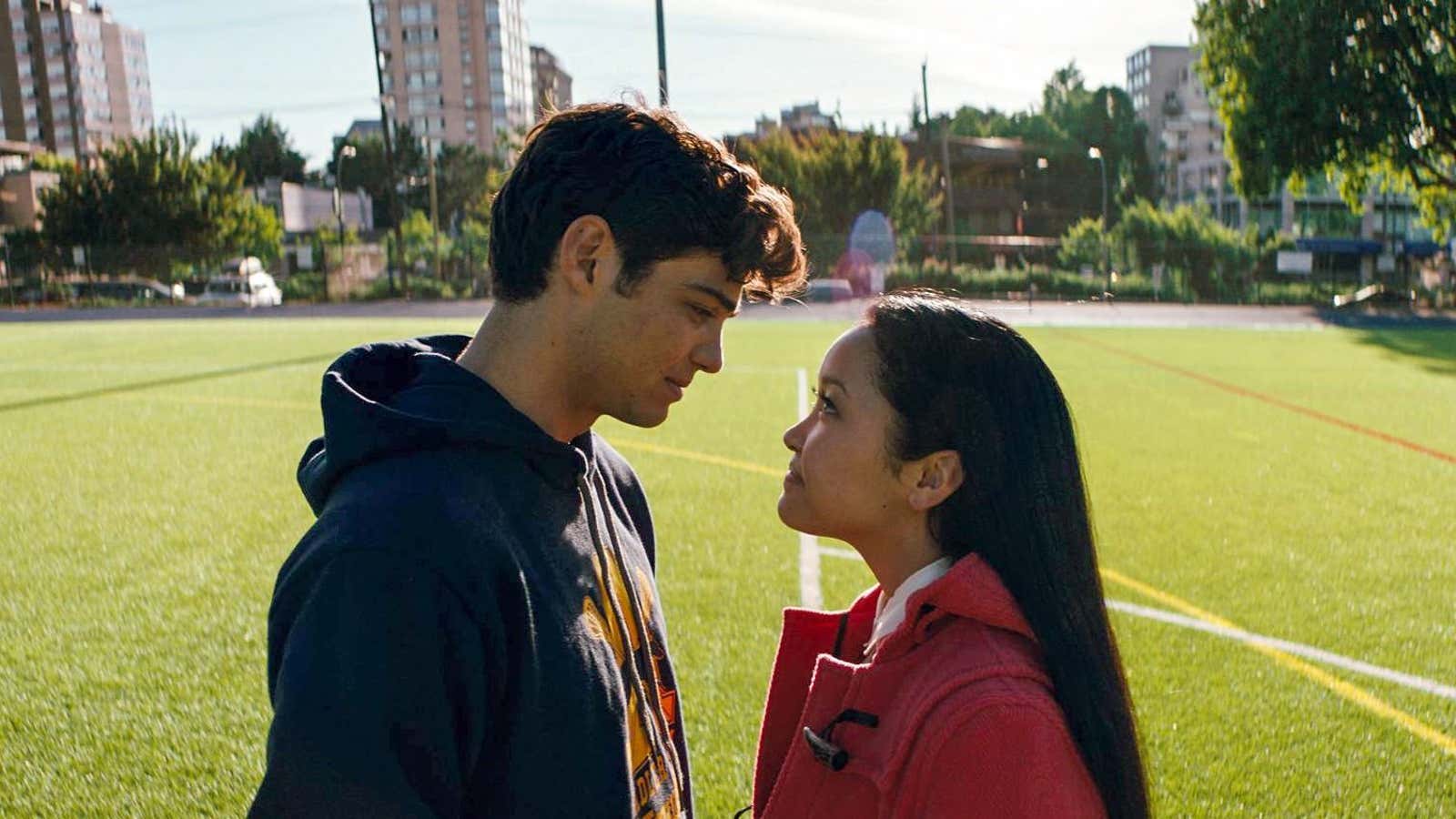In Stephen King’s The Body, the young narrator, having just creatively insulted his friends’ mothers, says, “I never had any friends later on like the ones I had when I was 12. Jesus, did you?” Readers may very well say the same about books. There are certain stories that, when read at formative times, like early adolescence, stick with us for life.
To All the Boys I’ve Loved Before is a new Netflix movie based on a three-book series by Jenny Han. The story is about high-school junior Lara Jean, her dreamed-up love life, and the moment it becomes a reality: The secret, never-to-be-sent letters to boys she’s liked over the years somehow make their way through the mail and to their dedicatees. To avoid awkwardness with one of the boys she still likes, she strikes up a fake relationship with one of the other recipients, the school It Boy.
It’s a silly movie in so many ways, not least of all for its contrived set-up. But it’s refreshing and deeply satisfying for one (bewilderingly) simple fact: The sight of a not-so-remarkable Asian American teenage girl at the heart of a rom-com love triangle with two white hunks. Lara Jean’s mother, who has passed away by the time the story starts, was Korean, and her father is half white. But her central conflict is not a clash of cultures; it’s the fallout from the fanciful antics of a teenage girl with her head in the clouds. The first book, which has spent at least 12 weeks on the New York Times bestseller list since its debut in 2014, has the potential to stick with a generation of young readers.
Of course this story comes from the YA book world. Young adult fiction, which in the US has its roots in the Judy Blume books of the 1970s, boomed again in the late 1990s and early 2000s. For a genre ostensibly for young humans still in development, at its best, YA is remarkably raw, challenging, and forward-thinking.
Something as good as To All the Boys I’ve Loved Before is possible precisely because YA has paved the road with its transgressive characters and themes, and the writers working in the genre who recognize the promise, flexibility, and optimism of young people.
In 1999, Laurie Halse Anderson published the landmark novel Speak. The book, about a girl who starts high school as a social outcast, seemingly for the usual teenaged reasons, was a critical success and a bestseller. By the end of the novel, the reader learns that her struggle to speak started after she was raped the previous summer.
That same year, there was Stephen Chbosky’s The Perks of Being a Wallflower, an anthem for kids with social anxiety; in 2007, Sherman Alexie’s The Absolutely True Diary of a Part-Time Indian gave readers a Native American character discovering whiteness for the first time; five years later, there was R.J. Palacio’s publishing sensation, Wonder, about a boy born with physical deformities going into his first year of formal schooling. The YA sensation of the past year has been Angie Thomas’ The Hate U Give, about a code-switching, teenaged black girl who sees her unarmed best friend shot and killed by the police.
The characters in these books, alongside their usual adolescent duties of being, like, totally misunderstood, deal head on with violent death, trauma, abuse, and racism.
There’s a long tradition of outsider heros in YA, and their alienness is not always specific to defined categories: There was Anne Shirley, an orphan with red hair; Matilda, the gifted daughter in a cruel family; and Mia Thermopolis, the frizzy-haired dork who’s secretly a princess. Not to mention all the teens whose hormonal freak-outs turned out to be super powers.
Many books for young folks succeed because they share a trait: They’re about, and by extension for, people who feel like misfits, outsiders maybe because they’re a member of a historically oppressed group, or maybe because they dress terribly. The best YA books succeed because they speak directly to the kind of 15-year-old who loves books: Someone looking for connection, and reassurance that weirdos can find love or acceptance. These books can provide potent wish fulfillment or much needed comfort to young people hoping it gets better.
These young heroes are sometimes overt outcasts, who overcome that fact to find their own weird tribe, develop a meaningful relationship, or discover peace through inner reflection. But just as subversive are the YA characters whose non-majority identities are not a major plot point.
In 2003, David Levithan (a former editor of this writer) published Boy Meets Boy, a book that depicted a dreamy high-school utopia, in which queer teens are downright normal, and where the homecoming queen is also nonchalantly the star quarterback. Most of the characters have bigger fish to fry than societal acceptance: They’re falling in love.
Jenny Han’s book belongs in this camp. The quiet revolution of Lara Jean’s story is that it’s not one of reconciliation with her ancestry. On the high-school spectrum, she’s not a loner, an anarchist, or a nerd. She’s just a conscientious, prudish indoors kid who prefers baking and rearranging her shoe collection to going on a school ski trip—a modern-day, middle-of-the-road Margaret.
The logical evolution of YA is towards the types of stories that show young Asian American girls they can be at the center of a cheesy rom com, much in the same way only now Crazy Rich Asians is doing for Asian American adults. Ultimately, that could move American culture toward perhaps an even more subversive future, in which teens—white, black, Muslim, straight, queer—can see themselves in a full spectrum of young people trying to find their way.
